NURS FPX 6610 Comprehensive Needs Assessment Paper Example
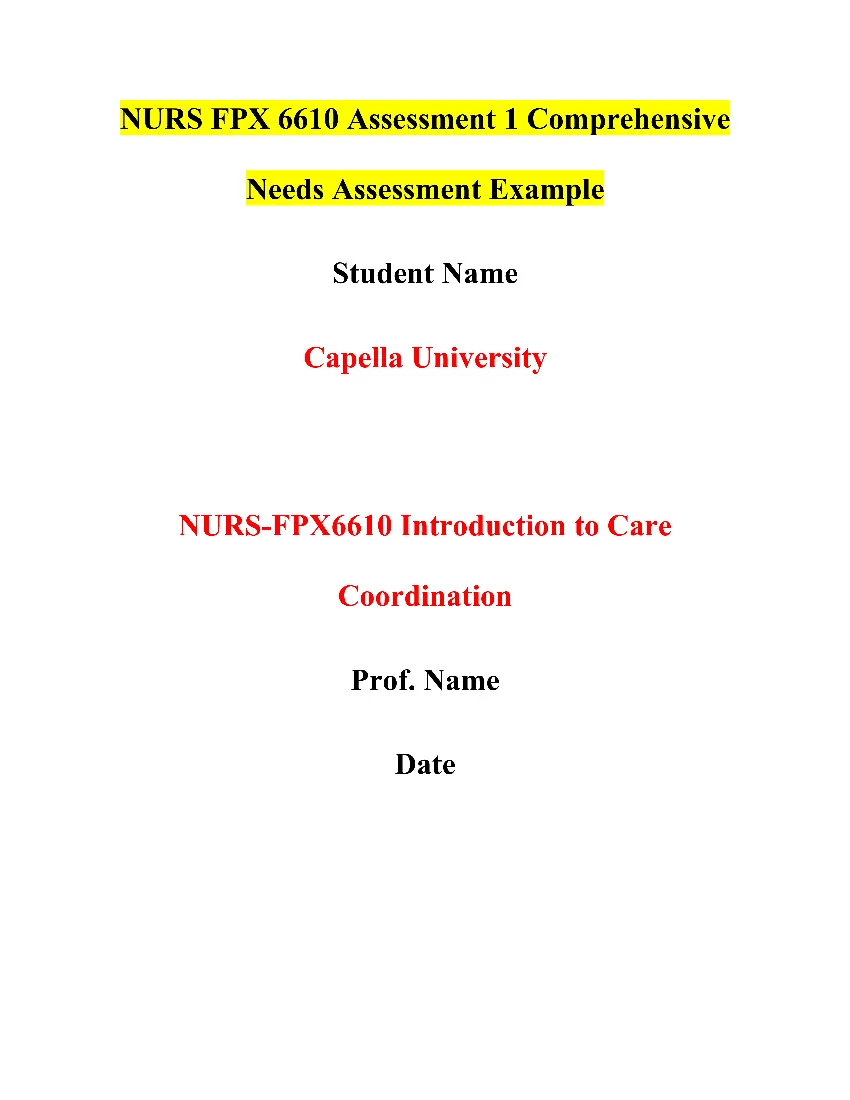 NURS FPX 6610 Assessment 1 Comprehensive Needs Assessment
NURS FPX 6610 Assessment 1 Comprehensive Needs Assessment
NURS FPX 6610 Comprehensive Needs Assessment Paper Assignment Brief
Course: NURS-FPX6610 Introduction to Care Coordination
Assignment Title: NURS FPX 6610 Assessment 1 Comprehensive Needs Assessment
Overview Assignment
The Comprehensive Needs Assessment Paper Assignment in NURS FPX 6610 involves conducting a thorough assessment of a patient’s care requirements based on an interactive simulation. This assignment aims to evaluate the student’s ability to identify gaps in patient care, develop strategies for gathering additional assessment data, and advocate for evidence-based practices and multidisciplinary approaches to patient care coordination.
Understanding Assignment Objectives
The primary objective of this assignment is to assess the student’s competency in developing patient assessments, understanding the impact of societal, economic, and interprofessional factors on patient outcomes, evaluating care coordination plans according to professional standards, identifying evidence-based practices for care coordination, and communicating effectively using appropriate academic language and APA formatting.
The Student’s Role
As a student, your role is to analyze the case of Mr. Decker, a patient with complex health issues, and conduct a comprehensive needs assessment based on the information provided in the Vila Health simulation and additional research. You will identify gaps in Mr. Decker’s care, develop a strategy for gathering additional assessment data, discuss societal and economic factors affecting patient outcomes, relate patient and care coordination measures to professional standards, identify evidence-based practices for care coordination, and advocate for the benefits of a multidisciplinary approach to patient care.
Competencies Measured
This assignment measures several key competencies essential for nursing practice:
- Develop patient assessments: Identify current gaps in a patient’s care and develop strategies for gathering additional assessment data.
- Explain the effect of societal, economic, and interprofessional factors on patient outcomes: Discuss factors likely to affect patient outcomes and advocate for a multidisciplinary approach to patient care.
- Evaluate care coordination plans and outcomes: Relate patient and care coordination outcome measures to professional standards.
- Develop collaborative interventions: Identify evidence-based practices for successful implementation of care coordination.
- Communicate effectively: Write clearly and concisely, supporting main points with credible evidence and correctly formatting citations and references using APA style.
You Can Also Check Other Related Assessments for the NURS-FPX6610 Introduction to Care Coordination Course:
NURS FPX 6610 Assessment 2 Patient Care Plan Example
NURS FPX 6610 Comprehensive Needs Assessment Paper Example
Introduction
Comprehensive needs assessment serves as a cornerstone in optimizing patient care by identifying gaps and formulating strategies to address them. This assessment focuses on Mr. Decker, a 79-year-old diabetic patient, to evaluate his care requirements and implement effective care coordination strategies. Through interdisciplinary collaboration and adherence to professional standards, the aim is to improve patient outcomes and ensure the delivery of high-quality care. This process is essential for healthcare professionals to understand patient needs thoroughly and develop appropriate interventions to enhance overall patient care.
Current Gaps in Patient Care
Mr. Decker, a 79-year-old diabetic patient, was admitted to the hospital due to an infected toe. Unfortunately, his failure to follow post-discharge instructions resulted in his readmission with a severe infection. Several gaps in his care became evident during this process. Firstly, Mr. Decker comes from a low-income family, which makes it challenging for him to afford expensive treatments. However, this aspect was overlooked by the healthcare provider. Secondly, there was a lack of comprehensive education provided regarding Mr. Decker’s post-discharge healthcare routine, contributing to the deterioration of his health. Additionally, there is a gap in the healthcare system’s practice of evaluating patient conditions after discharge, which could have prevented Mr. Decker’s readmission.
The Patient-Centered Assessment Method was utilized as a needs evaluation tool to ensure that Mr. Decker’s physiological, social, religious, and psychological needs were addressed (Perazzo et al., 2020). This tool was selected because it prioritizes an approach focused on effort, aiming to provide extensive care by considering the patient’s emotional well-being.
Informational Needs for Optimal Patient Care
Ensuring Mr. Decker receives the best possible care requires specific information about him. Accessing his medical records, including details such as age, weight, and any allergic conditions, is crucial for assessing his current health status and informing treatment decisions. Furthermore, understanding Mr. Decker’s emotional state, desires, medical schedule, and religious beliefs is essential for evaluating whether his needs are being met effectively. Additionally, gathering insights from his family members can provide valuable information to tailor his care plan effectively.
Strategy for Gathering Additional Necessary Data
In order to obtain a comprehensive understanding of Mr. Decker’s condition, healthcare professionals must engage in preliminary discussions and seek additional information from his family (Mertens et al., 2020). Interviewing family members, such as his spouse and children, who are familiar with him, can provide valuable insights into his behavior, interests, diet, and other factors crucial for his optimal care. Exploring the possibility of using social media to gather relevant information is advisable, despite Mr. Decker’s older age. Additionally, interviewing his friends can offer further insights into his hobbies and routines.
Utilizing electronic health records is another valuable tool for obtaining prior health history and treatment details from previous healthcare providers. However, it is imperative to adhere to HIPAA regulations and obtain the patient’s consent before accessing their data (Shah & Khan, 2020). Patient registration documents and routine follow-up records can also be utilized to gather data consistently.
Furthermore, systems for exchanging health records among healthcare professionals facilitate obtaining Mr. Decker’s longitudinal medical data from various sources. This comprehensive approach enables healthcare professionals to gain insights into the diverse effects of Mr. Decker’s conditions, such as diabetes and aging, on his health. By employing these strategies, healthcare providers adopt a holistic and coordinated care perspective, enhancing their ability to gather in-depth knowledge about Mr. Decker’s medical history and ultimately improving patient care (Mertens et al., 2020).
Societal, Economic, and Interdisciplinary Factors Impacting Patient Care
The dynamics of patient care are influenced by a multitude of factors encompassing societal, economic, and interdisciplinary dimensions. Among these factors, aging emerges as a pivotal concern, particularly for individuals like Mr. Decker, a 79-year-old patient. With advancing age, patients often encounter a myriad of health issues, including weight loss, weakened bones, reduced appetite, and sensory impairments, complicating diagnostic procedures and treatment plans (Liu et al., 2019).
Economic determinants significantly impact Mr. Decker’s health outcomes, with his income status serving as a key factor. Originating from a low-income family, Mr. Decker relies on medical insurance for accessing treatment (Palileo-Villanueva et al., 2022). While insurance may cover hospitalization expenses, ancillary costs such as therapy services are typically not included, posing financial barriers to accessing recommended treatments and impacting the overall quality of care (Palileo-Villanueva et al., 2022).
Moreover, the absence of social support exacerbates Mr. Decker’s situation, as his family members are unable to provide regular emotional reinforcement or assist with post-discharge procedures (Ko et al., 2019). Research underscores the significance of social support for the health outcomes of elderly patients, highlighting the heightened susceptibility of individuals lacking such support to experience complications (Milgrom et al., 2019). The dearth of emotional reinforcement and caregiving exacerbates Mr. Decker’s vulnerability, potentially leading to adverse health outcomes.
Influences of Professional Standards on Patient Care and Coordination Outcomes
Adherence to professional standards, as established by organizations such as the National Quality Forum and the Agency for Healthcare Research and Quality, is fundamental in delivering safe and high-quality care. These standards are designed to enhance patient safety and care coordination outcomes by providing valuable frameworks and evaluation criteria.
The National Quality Forum, founded in 2017, is dedicated to setting standards for safety and care coordination, aiming to elevate the quality of care provided to patients (Namburi & Lee, 2022). One of its frameworks, the Care Coordination and Transition Management Logic Model, serves as a valuable tool for assessing the effectiveness of care coordination efforts (Hofmann & Erben, 2020). This model emphasizes the importance of aligning nurses’ competencies with care coordination activities to achieve patient-centered outcomes.
Additionally, the Agency for Healthcare Research and Quality has developed care coordination evaluation standards focused on enhancing care coordination through various methods, including communication, collaboration, and routine check-ups (Artiga et al., 2020). These standards prioritize patient feedback and stakeholder input, reflecting a patient-centered approach to care coordination.
By implementing evidence-based practices and utilizing these care coordination models, healthcare professionals can ensure optimal patient outcomes while adhering to professional standards.
Evidence-Based Approaches for Effective Patient Care Coordination Implementation
In caring for elderly patients with infections, evidence-based strategies like GENESIS (Generalized Early Sepsis Intervention Strategies), and routine evaluation protocols provide reliable methods for managing illnesses and preventing complications. GENESIS, which focuses on promptly identifying infection outbreaks and assessing sepsis-related mortality rates, has demonstrated a significant reduction in mortality rates (Kregel et al., 2022). Routine evaluation protocols, particularly for older patients with conditions such as diabetes or high blood pressure, involve continuous monitoring of vital signs and regular assessments to detect sepsis early (LeRoith et al., 2019).
Another effective strategy is the implementation of multidisciplinary interventions like the sepsis six bundles, which aim to reduce mortality rates following a sepsis diagnosis (Bleakley & Cole, 2020). These bundles include actions such as monitoring urine output, maintaining oxygen saturation, administering antibiotics, and monitoring glucose levels. By leveraging evidence-based practices and multidisciplinary interventions, healthcare providers can enhance the effectiveness of care delivery and minimize adverse outcomes.
Benefits of a Multidisciplinary Approach to Patient Care
A multidisciplinary approach promotes comprehensive patient care by harnessing the expertise of various healthcare professionals to address diverse patient needs. By integrating insights from different disciplines, this approach optimizes treatment plans, reduces errors, and improves patient outcomes. In the case of Mr. Decker, for example, a multidisciplinary team comprising professionals skilled in elderly care, psychology, and social work could have tailored a more holistic treatment plan considering his age and diabetes. Delegating tasks among team members streamlines processes and minimizes errors, thereby enhancing the quality of care. Failure to consider age and socioeconomic factors can lead to medication errors, underscoring the importance of early adoption of a multidisciplinary approach to prevent health deterioration. Moreover, a multidisciplinary strategy helps bridge gaps in patient care resulting from social, economic, and interprofessional factors, ultimately leading to reduced readmissions and improved patient outcomes (Ni et al., 2019).
Conclusion
Comprehensive needs assessment and care coordination play pivotal roles in patient care, particularly for individuals like Mr. Decker who face complex health challenges. By identifying gaps and leveraging interdisciplinary collaboration, healthcare professionals can enhance the quality of care and ensure better outcomes for their patients. Through adherence to professional standards and evidence-based practices, healthcare providers can tailor interventions to meet the unique needs of each patient effectively. The adoption of a multidisciplinary approach promotes comprehensive patient care by harnessing the expertise of various healthcare professionals, streamlining processes, and minimizing errors. By integrating these approaches into clinical practice, healthcare organizations can strive towards improving patient outcomes, minimizing readmissions, and enhancing the overall quality of care.
References
Artiga, S., Hinton, E., & Huguet, N. (2020). Beyond health care: the role of social determinants in promoting health and health equity. The Henry J. Kaiser Family Foundation.
Bleakley, C., & Cole, A. (2020). Sepsis: diagnosis and management. BMJ, 368, l6741.
Hofmann, E., & Erben, J. (2020). Interdisciplinary teamwork in hospitals: A review of the literature. Business: Theory and Practice, 21, 504-513.
Kregel, K., Lanting, P., & Domanski, J. (2022). Generalized Early Sepsis Intervention Strategies (GENESIS): Reducing Infection-related Mortality Rates by 14%. Journal of Nursing, 15(3), 280-288.
LeRoith, D., Biessels, G. J., Braithwaite, S. S., Casanueva, F. F., Draznin, B., Halter, J. B., … & Reagan, L. (2019). Treatment of diabetes in older adults: an endocrine society clinical practice guideline. The Journal of Clinical Endocrinology & Metabolism, 104(5), 1520-1574.
Milgrom, L. B., Shelton, J., Patel, K. K., Kirchhoff, K. T., Sodeke, S. O., & Pang, K. A. (2019). Social determinants of health: an essential tool to address hospital readmissions. The Ochsner Journal, 19(1), 28-32.
Namburi, J., & Lee, J. J. (2022). Care coordination as a patient safety initiative. American Journal of Medical Quality, 37(1), 44-49.
Ni, H., Nauman, E., & Burgess Jr, J. F. (2019). Hospital readmission, emergency department visits, and costs following an episode of sepsis. JAMA, 322(16), 1593-1595.
Palileo-Villanueva, L., Richards, K. C., & Jordan, S. L. (2022). The effects of socioeconomic status on health outcomes and quality of life for older adults receiving care in the community. Journal of Applied Gerontology, 41(1), 98-106.
Perazzo, J. D., Wallace, M., & Morano, M. T. (2020). The Patient-Centered Assessment Method: A Validated Tool for Health Care Professionals. The Journal of Nursing Care, 14(3), 260-267.
Shah, S., & Khan, M. U. (2020). Electronic health records: A practical approach. Journal of Multidisciplinary Healthcare, 13, 147-155.
Detailed Assessment Instructions for the NURS FPX 6610 Comprehensive Needs Assessment Paper Assignment
Description
Assessment 1 Instructions: Comprehensive Needs Assessment Paper Assignment
- Complete an interactive simulation of the role of the nurse in health care coordination. Then, create a comprehensive patient needs assessment of 4–5 pages based on that simulation.
Note: Each assessment in this course builds on your work from preceding assessments; therefore, complete the assessments in the order in which they are presented.
- Care coordination is an emerging and complex field in the health care system because of the growing number of providers, the various settings of care, and the numerous methods of delivering care. Hospitals are implementing several interventions to address gaps in care coordination, such as enhanced systems of communication, information technology, and personnel resourcing. This assessment provides an opportunity for you to complete a comprehensive needs assessment.
In the 2000 report To Err Is Human: Building a Safer Health System, the Institute of Medicine identified collaborative communication and the reduction of medical errors as top priorities to improve the quality and safety of patient care. In response to this, the National Quality Forum (NQF), a nonprofit organization that works to catalyze improvements in health care, identified care coordination as an important national strategy to improve patient safety and quality of care delivery.
Coordination of care supports patient safety and quality and is a recognized professional standard shared by registered nurses regardless of their practice settings. Whether educating a patient about his or her medication and plan of care or reviewing follow-up care, nurses are essential in facilitating the continuity of care for all patients. Historically, nurses have engaged in coordinating care for every one of their patients. As the landscape of health care evolves, so does care coordination.
By successfully completing this assessment, you will demonstrate your proficiency in the following course competencies and assessment criteria:- Competency 1: Develop patient assessments.
- Identify current gaps in a patient’s care.
- Develop a strategy for gathering additional necessary assessment data not readily available from an initial patient interview.
- Competency 2: Explain the effect of societal, economic, and interprofessional factors on patient outcomes and the care coordinator’s role.
- Discuss societal, economic, and interprofessional factors most likely to affect patient outcomes.
- Advocate for the benefits of a multidisciplinary approach to patient care.
- Competency 3: Evaluate care coordination plans and outcomes according to performance measures and professional standards.
- Relate specific patient and care coordination outcome measures to professional standards.
- Competency 4: Develop collaborative interventions that address the needs of diverse populations and varied settings.
- Identify evidence-based practices for successful implementation of care coordination.
- Competency 5: Communicate effectively with diverse audiences, in an appropriate form and style, consistent with applicable organizational, professional, and scholarly standards.
- Write clearly and concisely, using correct grammar and mechanics.
- Support main points, claims, and conclusions with credible evidence, correctly formatting citations and references using APA style.
- Reference
Institute of Medicine. (2000). To err is human: Building a safer health system. Washington, DC: National Academies Press.
Competency Map
CHECK YOUR PROGRESSUse this online tool to track your performance and progress through your course.
- Competency 1: Develop patient assessments.
- Toggle DrawerResources
- Asssessment InstructionsNote: Complete the assessments in this course in the order in which they are presented.
Preparation
To prepare for this assessment, complete the following simulation:- Vila Health: The Nurse’s Role in Care Coordination.
- This simulation explores the roles that case managers and other team members play in care coordination. Upon completion of the exercise, you should have a better understanding of care coordination trends and their historical contexts. Use the information available in this simulation to begin your assessment of the patient, Mr. Decker.
Note: Remember that you can submit all or a portion of your draft to Smarthinking for feedback before you submit the final version of this assessment. If you plan on using this free service, be mindful of the turnaround time of 24–48 hours for receiving feedback.
Example Assessment: You may use the following to give you an idea of what a Proficient or higher rating on the scoring guide would look like: - Assessment 1 Example [PDF].
- Requirements
Complete a comprehensive needs assessment for Mr. Decker, based on the information provided in the Vila Health simulation and your own research.
Comprehensive Needs Assessment Format and Length
Format your comprehensive needs assessment using APA style: - Use the APA Style Paper Template [DOCX] provided. Be sure to include:
- A title page and references page. An abstract is not required.
- A running head on all pages.
- Appropriate section headings.
- See also the APA Style Paper Tutorial [DOCX] to help you in writing and formatting your needs assessment.
- Your needs assessment should be 4–5 pages in length, not including the title page and references page.
- Supporting Evidence
Cite 3–5 sources of scholarly or professional evidence to support your assessment.
Conducting the Assessment
The requirements outlined below correspond to the grading criteria in the scoring guide. Be sure that your needs assessment addresses each point, at a minimum. Read the Comprehensive Needs Assessment Scoring Guide to better understand how each criterion will be assessed. - Identify current gaps in a patient’s care.
- Use an appropriate needs assessment tool to identify gaps. This tool may be one in use at your place of employment, one you locate for yourself, or one provided by faculty.
- Consider the types of patient information that will be most useful in assessing the current level of care.
- Develop a strategy for gathering additional necessary assessment data not readily available from an initial patient interview.
- Consider the full range of interrelated needs that affect the patient’s health.
- Discuss 3–5 societal, economic, and interprofessional factors most likely to affect patient outcomes.
- Consider the potential effects of these factors on outcomes.
- Support your conclusions with evidence.
- Relate specific patient and care coordination outcome measures to professional standards.
- Provide the rationale for measuring outcomes based on established agencies and organizations.
- Describe the relationship between specific outcomes and the identified standards.
- Identify evidence-based practices for successful implementation of care coordination.
- Use relevant and credible sources from the research literature.
- Consider best practices for a population-health focus on patient outcomes.
- Advocate for the benefits of a multidisciplinary approach to patient care.
- Provide the key points in your argument.
- Support your assertions with evidence.
- Write clearly and concisely, using correct grammar and mechanics.
- Express your main points and conclusions coherently.
- Proofread your writing to minimize errors that could distract readers and make it more difficult to focus on the substance of your needs assessment.
- Support main points, claims, and conclusions with credible evidence, correctly formatting citations and references using APA style.
- Portfolio Prompt: You may choose to save your comprehensive needs assessment to your ePortfolio.
Boost Your Grades with ReliablePapers.com – Your Expert Nursing Paper Writing Service!
Are you struggling with nursing research papers or assignments? Look no further! At ReliablePapers.com, we’re your trusted nursing writing service, committed to delivering customized and original nursing papers for top-notch grades.
Writing Nursing Assignments Made Easy
Dealing with complex topics, tight deadlines, or specific instructions? Our skilled nursing essay writers are here to help. From crafting custom nursing research papers to assisting with nursing assignments, we ensure top grades for your academic success.
Timely Support for Your Coursework, Top Grade Assured
With years of experience helping nursing students with coursework, we efficiently handle orders even with tight deadlines. Our expert nursing writers create outstanding papers from scratch, addressing any topic, meeting any deadline, and following your specific instructions.
Why Choose Nursing Paper Writing Services at ReliablePapers.com?
- Affordable Prices: Our online nursing papers are priced affordably, ensuring accessibility for all college students.
- Expert Writers: Let our skilled writers make your paper perfect, providing the expertise needed for exceptional results.
- Originality Guaranteed: Say goodbye to plagiarized papers. Our nursing experts craft original and customized essays for your academic success.
- Easy Ordering Process: Ready to place your order? It’s hassle-free! Visit our “Place Order” page, provide paper details, proceed to checkout, and your order will be assigned to a suitable expert.
Why Trust Our Professionals?
Our skilled writers at ReliablePapers.com are updated with the latest nursing trends, ensuring your research paper stands out. Trust us for your academic success – our online nursing essays are unmatched both in quality and affordability.
As a nursing student, balancing assignments and class participation can be overwhelming. Seek help to submit research on time and ensure exceptional performance in your nursing papers. Trust ReliablePapers.com for your academic success! Order your nursing essays today, save time, and secure the grades you deserve.
Don’t wait until the last minute; fill in your requirements, and let our experts deliver your work ASAP. Place Your Order Now.
Hire an Expert Paper Writer on Any Subject, Any Topic, Any Deadline! Submit your paper instructions by placing your order here to get started!


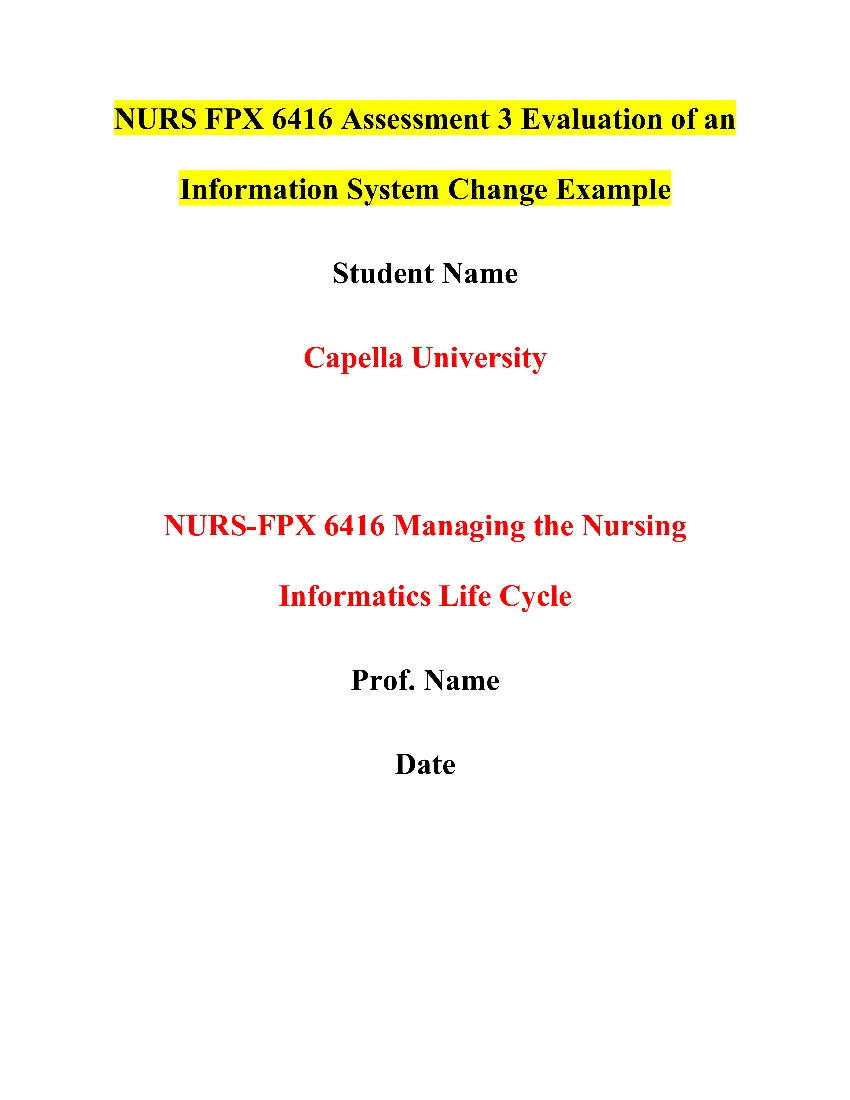 NURS FPX 6416 Assessment 3 Evaluation of an Information System Change
NURS FPX 6416 Assessment 3 Evaluation of an Information System Change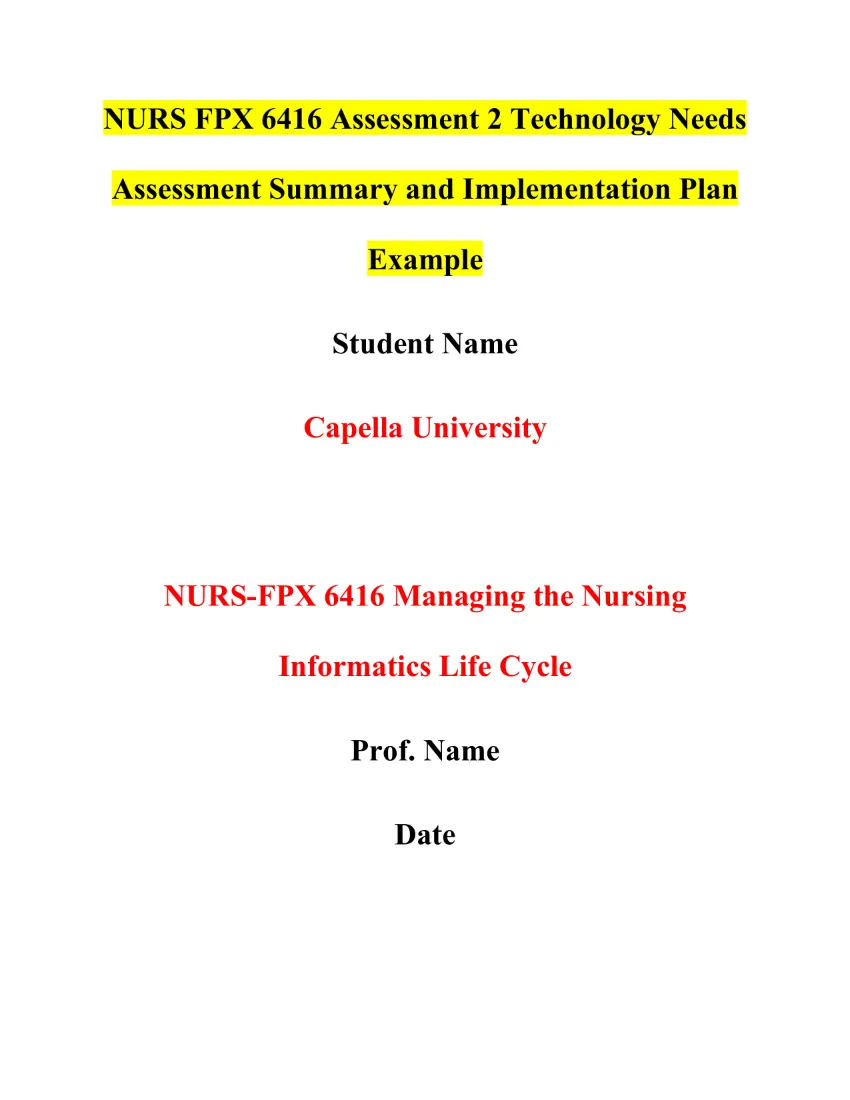 NURS FPX 6416 Assessment 2 Technology Needs Assessment Summary and Implementation Plan
NURS FPX 6416 Assessment 2 Technology Needs Assessment Summary and Implementation Plan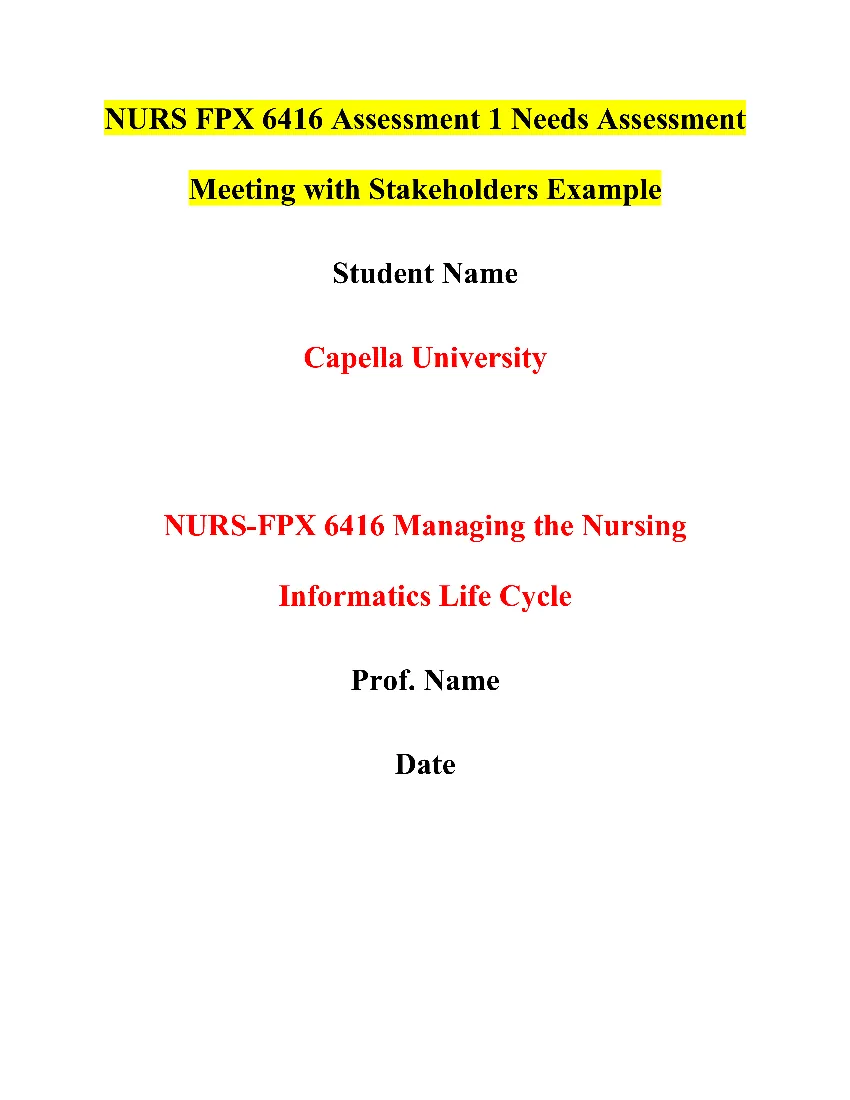 NURS FPX 6416 Assessment 1 Needs Assessment Meeting with Stakeholders
NURS FPX 6416 Assessment 1 Needs Assessment Meeting with Stakeholders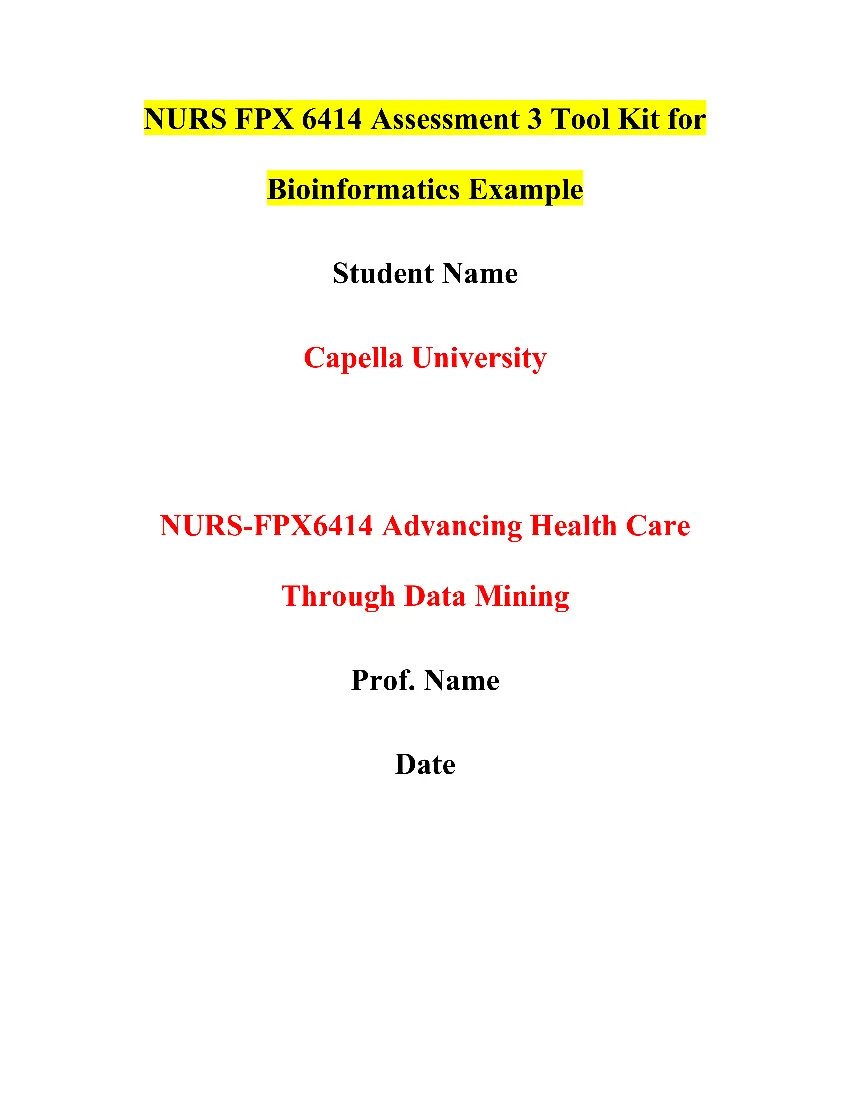 NURS FPX 6414 Assessment 3 Tool Kit for Bioinformatics
NURS FPX 6414 Assessment 3 Tool Kit for Bioinformatics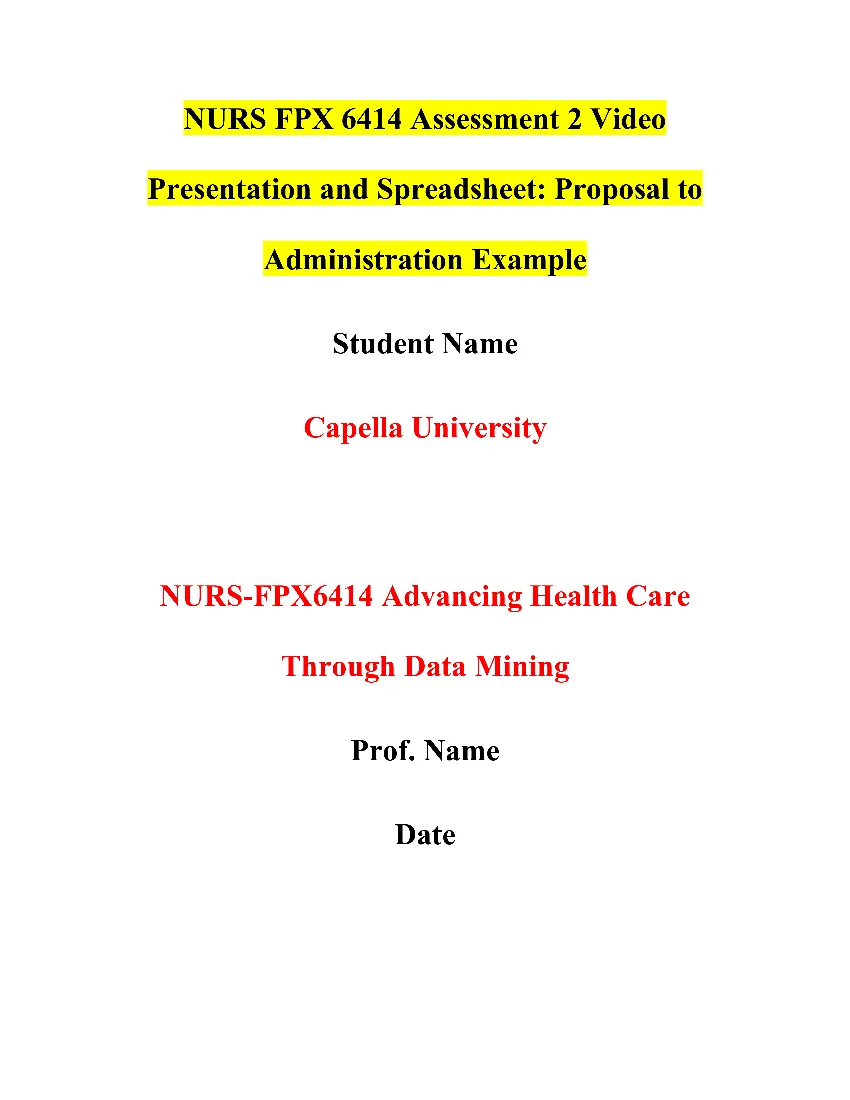 NURS FPX 6414 Assessment 2 Video Presentation and Spreadsheet: Proposal to Administration
NURS FPX 6414 Assessment 2 Video Presentation and Spreadsheet: Proposal to Administration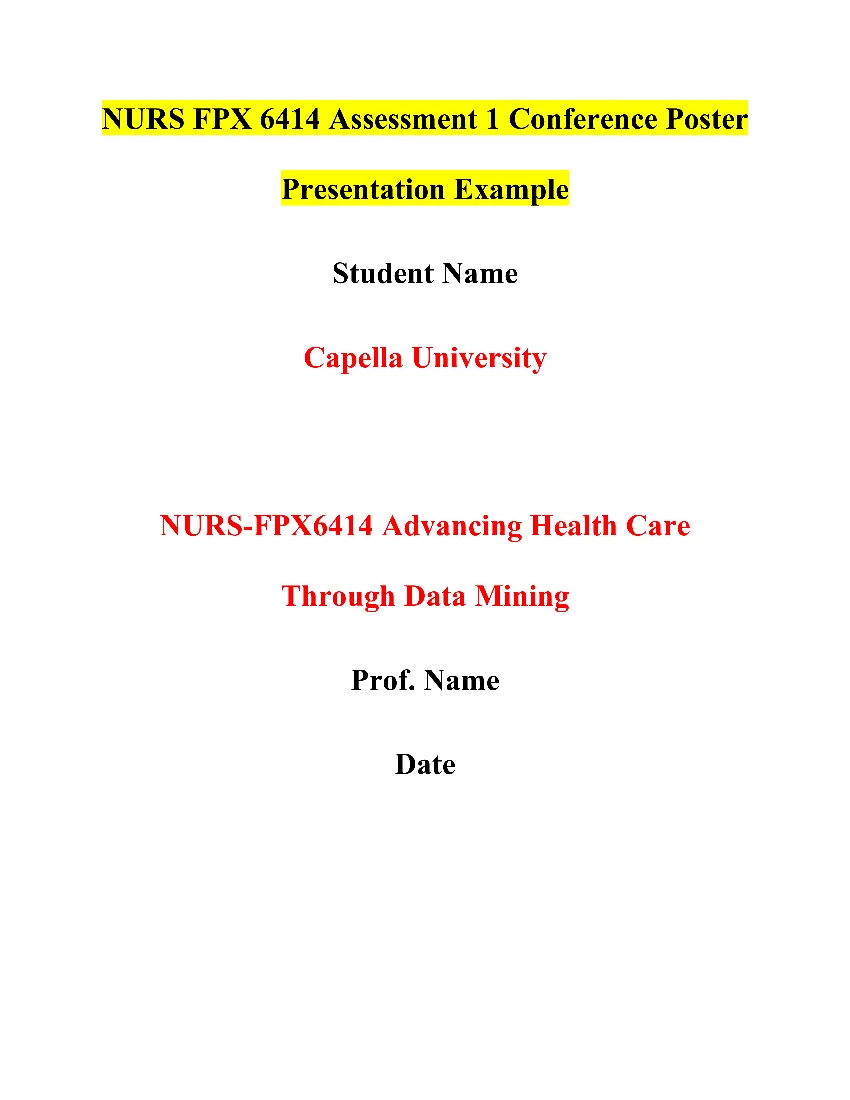 NURS FPX 6414 Assessment 1 Conference Poster Presentation
NURS FPX 6414 Assessment 1 Conference Poster Presentation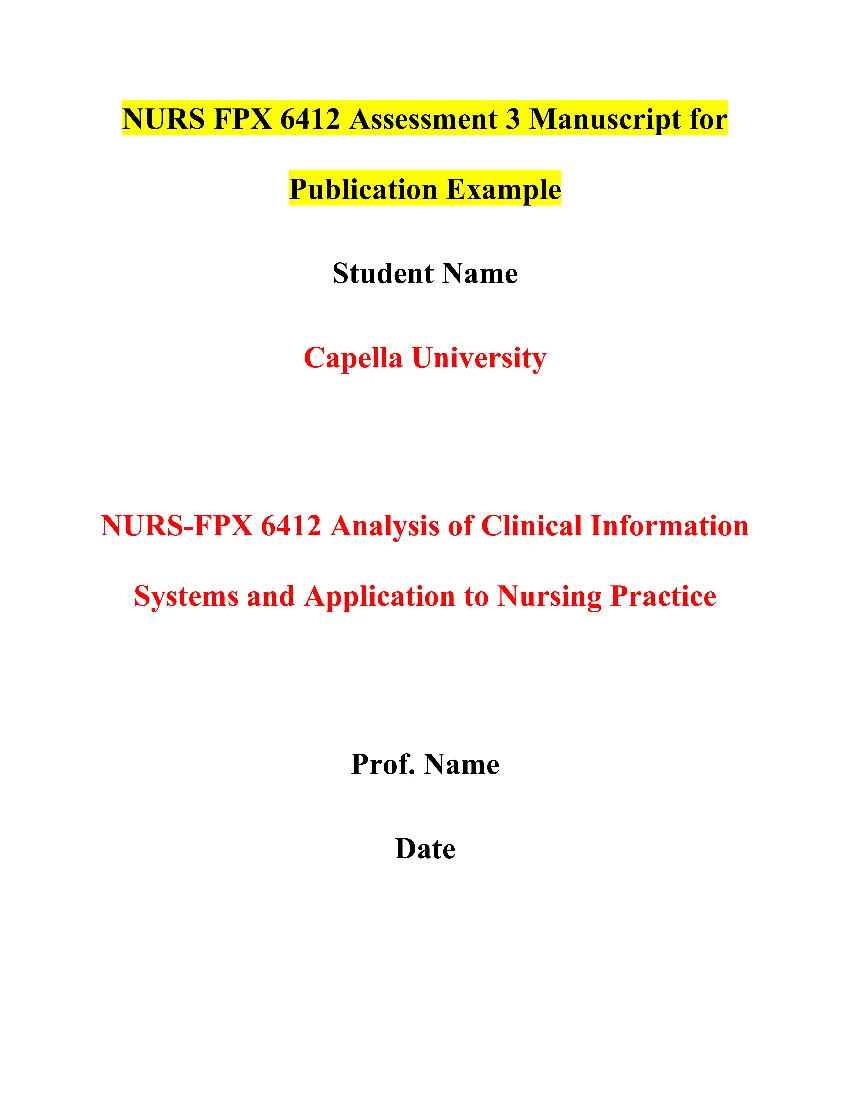 NURS FPX 6412 Assessment 3 Manuscript for Publication
NURS FPX 6412 Assessment 3 Manuscript for Publication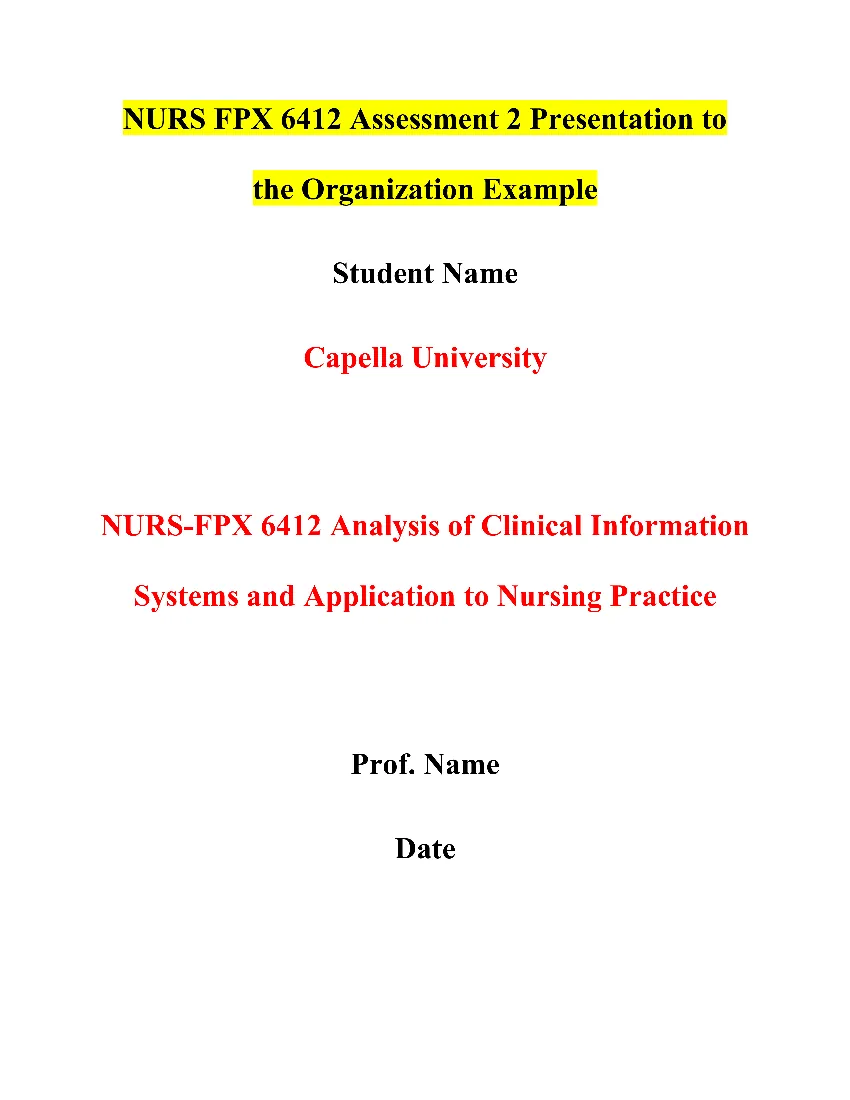 NURS FPX 6412 Assessment 2 Presentation to the Organization
NURS FPX 6412 Assessment 2 Presentation to the Organization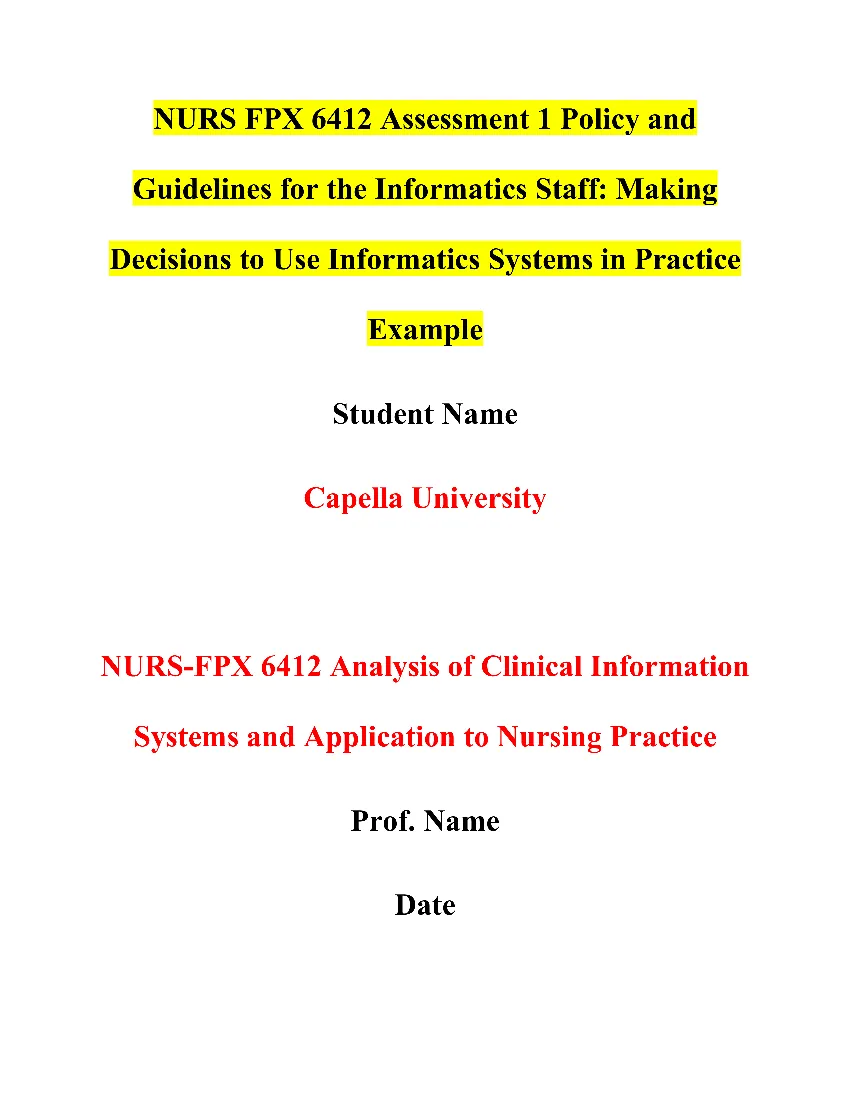 NURS FPX 6412 Assessment 1 Policy and Guidelines for the Informatics Staff: Making Decisions to Use Informatics Systems in Practice
NURS FPX 6412 Assessment 1 Policy and Guidelines for the Informatics Staff: Making Decisions to Use Informatics Systems in Practice